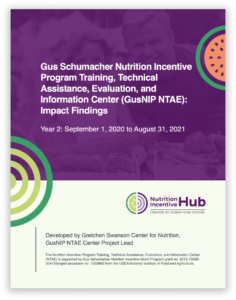MAKE TWICE THE IMPACT
Help us support healthier families, stronger local economies, and a more resilient food system for us all.
Your gift today will be matched thanks to the Hamp Family Fund.
Erica Christensen Raml and Andi Nank contributed to this article.

| The 2022 Nutrition Incentive Hub annual convening brought together partners and practitioners from coast to coast to share ideas, elevate exciting work happening in the field, and dig into the latest insights from the latest findings. This year’s event brought together 120 speakers in 33 sessions across three days. They covered the latest happenings in nutrition incentive and produce prescription projects. It was attended by more than 1,000 people—a 15 percent increase in attendance from last year!
What made this year’s convening stand out? The inspiring community itself. We learned from previous events that people want to hear directly from practitioners, or the people on the ground who are running a nutrition incentive or produce prescription projects and are currently receiving USDA GusNIP grants. So, we worked closely with our partners at the Nutrition Incentive Hub to plan this year’s event with such feedback in mind. And we’re pleased with the results! To develop the agenda, we had an open call for sessions and GusNIP grantees and practitioners submitted proposals to share their experiences and programs with a range of people in the field, from newbies to other experts. Additionally, this free virtual event opened access to this information to more people and, by extension, provided opportunities for attendees to learn, network, and share ideas both in the sessions and through the virtual platform. See below for highlights from our three days together including top take-aways from the latest impact report and other trends from the field.
|
The Nutrition Incentive Hub works with produce prescription and nutrition incentive projects across the U.S. to help them grow and evaluate their impact in communities. These programs support the health and wealth of more families, farmers, and food retailers by expanding access to fresh, healthy fruits and vegetables.
What is GusNIP? The Gus Schumacher Nutrition Incentive Program (GusNIP) is a four-year effort funded by the U.S. Department of Agriculture through the 2018 Farm Bill. What is the Nutrition Incentive Hub? In fiscal year 2019, $41 million was awarded, with $8.5 million for the creation of the GusNIP Training, Technical Assistance, Evaluation, and Information Center (NTAE). The GusNIP NTAE Center created the Nutrition Incentive Hub, a coalition of partners to support nutrition incentive and produce prescription projects. Under the 2014 Farm Bill, $85.6 million was awarded from 2015 to 2018, through the previous funding mechanism known as the Food Insecurity Nutrition Incentive program (FINI). Why was it created? The Nutrition Incentive Hub provides training, technical assistance, reporting, and evaluation support to help strengthen nutrition incentive and produce prescription projects, as they work to increase the purchase of fruits and vegetables by project participants. |
As lead for the Nutrition Incentive Hub, our partner Gretchen Swanson Center for Nutrition (GSCN) is charged with providing evaluation support to all 78 projects funded by USDA Gus Schumacher Nutrition Incentive Program (GusNIP). This ranges from large-scale, multi-year projects to one-year pilots and produce prescription projects as well as evaluating the overall impact of the GusNIP program. The Convening kicked off with GSCN, sharing key findings from the Hub’s second year.
 The biggest finding—if not the biggest takeaway from the report—is that those who participate in nutrition incentive programs, like Double Up Food Bucks, eat more produce than the average adult.
The biggest finding—if not the biggest takeaway from the report—is that those who participate in nutrition incentive programs, like Double Up Food Bucks, eat more produce than the average adult.
Another exciting finding is that those who participated in nutrition incentive programs ate more fruits and vegetables the longer they participated. Those who participated in produce prescription projects—which allows healthcare providers to prescribe fruits and vegetables during routine visits to people experiencing nutrition insecurity and/or dealing with diet-related chronic illness—also ate more produce and were able to improve their nutrition security as a result.
Other key findings are that nutrition incentive programs nationwide successfully distributed an extraordinary amount of incentives, equaling more than $20 million in fruit and vegetable purchases. The incentives that were redeemed at local food retail outlets generated an economic impact of approximately $41 million.
Let me break this finding down a bit: what we mean by “incentive” in this case is extra food dollars that can only be used to buy fruits and vegetables. In the case of a “produce prescription,” a healthcare provider prescribes that to their patient to buy more fruits and vegetables to help regulate their high blood pressure or diabetes. The prescription includes the amount of food dollars needed to purchase the additional vegetables and fruit. “Nutrition incentive programs” work to help people participating in the Supplemental Nutrition Assistance Program, SNAP—or what was formerly known as food stamps—increase their food budget so they can bring home more healthy food like fresh produce with their SNAP and incentive dollars. For example, the Double Up Food Bucks program in Michigan gives a SNAP user one dollar for every dollar they spend on produce, up to $20 a day, which increases their food budget from $20 to $40. Knowing that the program is essentially giving them more money to buy fruits and vegetables encourages the person to buy more of them.
So, back to the finding I mentioned, people using nutrition incentive programs like Double Up Food Bucks have redeemed $20 million in these kinds of incentives nationwide and, furthermore, people who used these incentives at local food outlets—be that a farmers market, an independent grocery store, or a corner store—put $41 million back into their communities!
Learn more about the health and economic impacts of GusNIP-supported projects in the newly published Year 2 Impact Report.
The major themes we noticed at this year’s Convening include:
Dr. Sara Bleich, Director of Nutrition Security and Health Equity in the Food and Nutrition Service at the U.S. Department of Agriculture, keynoted the second day of the Convening. Dr. Bleich previously served as the Senior Advisor for COVID-19 in the Office of the Secretary at USDA (2021) and is a policy expert and researcher who specializes in diet-related diseases, food insecurity and racial inequality with more than 175 peer-reviewed publications. During her keynote, she shared the Biden Administration’s priorities around nutrition security and racial equity. She noted that GusNIP, nutrition incentives, and produce prescription programs are part of this Administration’s larger nutrition security vision and plans, connecting the work of the Nutrition Incentive Hub to larger policy priorities.
As mentioned, we had an open call for session proposals from the field and from partners, which led to a very rich agenda featuring a variety of perspectives and programs from all across the country. An example came from one of our partners, The Food Trust, about anti-fat bias in nutrition incentive work. Presented by Ragen Chastain, the session explored how many public-health professionals and nutrition incentive programs inadvertently harm the communities and individuals they are trying to support by perpetuating anti-fat bias. An example of this is when an incentive program focuses on obesity as the “problem” they seek to address or misuse BMI as a proxy for health. Chastain aimed to assist practitioners to approach their work in ways that don’t reinforce stigma against larger bodies.
We also showcased statewide collaborations and different regions of the country, such as Hawai’i. The session, “Ho’olako Kūpuna = People who Supply, Equip, and Enrich Older Adults,” explored how Hawai’i’s unique mix of geography, culture, and demographics created extra challenges during the pandemic, including alarming nutrition insecurity rates.
Technology was another area for shared learning. The event featured a range of topics for people at the beginning stages of operations to those that are scaling their programs. People were also hungry—no pun intended!—to hear about policy, specifically how GusNIP is part of a larger strategy of the Biden administration.
More learnings from the field shared at the Convening are available to the public. Recordings from this year’s Convening are available until April 30, 2022.
Learn more about the Nutrition Incentive Hub.

Erica Christensen Raml |

Rachel Hoh |

Whitney Smith |